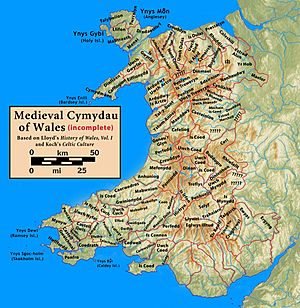Y Gorddwr facts for kids
Y Gorddwr (also known as Corddwr) was a small area of land in medieval Wales. It was like a mini-county, called a commote in Welsh. Y Gorddwr was part of a larger region called Ystlyg, which was itself part of the Kingdom of Powys.
This land was located on the eastern side of the River Severn, right next to England. To its west, it shared borders with two other commotes: Deuddwr to the north and Ystrad Marchell to the south. The name Y Gorddwr comes from Welsh words meaning "the upper water."
Contents
Who Claimed Y Gorddwr?
After the Norman Conquest of England (when William the Conqueror took over in 1066), English lords started to claim lands in Wales. Y Gorddwr was claimed by Roger le Corbet. He was a powerful English lord, known as the Baron of Caus, and his lands were part of a larger area controlled by Roger de Montgomerie, 1st Earl of Shrewsbury. These border areas were called the Marcher Lordships.
A Fight for the Land
Gruffydd's Claim
In 1241, a Welsh prince named Gruffydd ap Gwenwynwyn got back most of the lands his father had lost around 1216. Gruffydd immediately said that Y Gorddwr belonged to him because his family had owned it for a long time. This led to a big disagreement with the Corbet family.
Gruffydd was actually related to the Corbets through his mother, Margaret. She was the sister of Thomas Corbet, who was the Baron of Caus at that time. This family connection made Gruffydd's claim even stronger. He inherited his mother's lands in Y Gorddwr in 1246. Then, in 1252, he took control of even more land there. This happened when King Henry III of England was busy arguing with a powerful English lord named Simon de Montfort, 6th Earl of Leicester.
Thomas Corbet was not happy about this. In 1255, he took Gruffydd to court. The English lords who heard the case decided that Gruffydd was wrong and that the land belonged to Corbet.
Changing Sides
In 1257, before Gruffydd could give the land back, another powerful Welsh prince, Llywelyn ap Gruffudd, took over Gruffydd's territory in Powys. Llywelyn forced Gruffydd to leave Wales and go to England.
Even though Gruffydd had lost his lands, King Henry III still insisted that he hand over the territory he held in Y Gorddwr to Corbet. So, in 1263, Gruffydd decided to switch his loyalty to Llywelyn. Because of this, Llywelyn gave Gruffydd his lands back.
Gruffydd then fought alongside Llywelyn and Simon de Montfort against the English king. This alliance lasted until Simon de Montfort was defeated and killed at the Battle of Evesham in 1265. In 1267, Llywelyn and Gruffydd made a deal with the king in the Treaty of Montgomery. They agreed to stop fighting.
More Disagreements
King Henry III died in 1272. After his death, Llywelyn started fighting against England again. But this time, Gruffydd chose to side with England against Llywelyn. Because of this, Gruffydd lost his territories once more.
In 1274, Gruffydd, along with his son Owain and Dafydd ap Gruffudd, were part of a plan to kill Llywelyn. The plan failed, and Gruffydd had to run away to Shrewsbury in England. From there, he led attacks against Llywelyn and supported King Edward I's efforts to take away Llywelyn's power.
In 1277, Llywelyn was forced to accept King Edward's terms. Gruffydd was rewarded for helping Edward and got his lands in Powys back. However, he continued to claim Y Gorddwr from Peter Corbet (Thomas Corbet's successor). Even after Gruffydd died, his family kept arguing about who owned the land and who should get the taxes from it.


